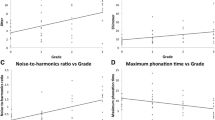Abstract
Perceptual rating scales are widely used in voice quality assessment, yet apart from the GRBAS scale, their reliability has been poorly demonstrated. There are no studies that have compared the optimal reliability of experienced judges using different auditory rating scales in a controlled experimental environment. This study aimed to assess the reliability of three common scales (The Buffalo Voice Profile , The Vocal Profile Analysis Scheme (VPA) and GRBAS. Sixty-five varyingly dysphonic and five normal voices were recorded onto CD in random order. Thirty voices were recorded twice. Seven experienced and trained speech and language therapists rated all voices on the three scales. Only the overall grade was found to be reliable for the Buffalo Voice Profile. The reliability of the VPA scheme was found to be poor to moderate. The VPA may have a use as a multi-dimensional and in-depth evaluation of voice types, but its greater scope is at the expense of reliability. The GRBAS was reliable across all parameters except Strain. Our detailed reliability analysis comparing performance of three commonly used rating scales provides further evidence to support the GRBAS as a simple reliable measure for clinical use.



Similar content being viewed by others
References
Altman G (1991) Practical statistics for medical research. Chapman and Hall
Carding P, Carlson E, Epstein R, Mathieson L, Shewell C (2000) Formal perceptual evaluation of voice quality in the United Kingdom. Log Phon Vocol 25:133–138
De Bodt MS, Heyning VD, et al (1996) The perceptual evaluation of voice disorders. Acta Otorhinolaryngol Belg 50:283–291
De Bodt MS, Wuyts FL, Van de Heyning PH, Croux C (1997) Test-retest study of the GRBAS scale: influence of experience and professional background on perceptual ratings of voice quality. J Voice 11:74–80
Dejonckere PH, Obbens C, de Moor GM, Wieneke GH (1993) Perceptual evaluation of dysphonia: reliability and relevance. Folia Phonair 45:76–83
Dejonckere PH (1995) Principal components in voice pathology. Voice 4:96–105
Dejonckere P, Lebacq J (1996) Acoustic, perceptual, aerodynamic and anatomical correlations in voice pathology. ORL 58:326–332
Dejonckere P,Remacle M (1996) Differentiated perceptual evaluation of pathological voice quality: reliability and correlations with acoustic measurements. Rev Laryngol Otol Rhinol 117:219–224
Dejonckere P, Remacle M (1998) Reliability and clinical relevance of perceptual evaluation of pathological voices. Rev Laryngol Otol Rhinol 119:247–248
Dejonckere P, Lebacq J (2001) Plasticity of voice quality: a prognostic factor outcome of voice therapy. J Voice 15:251–256
Fairbanks G (1960) Voice and articulation drillbook. Harper Row, New York
Gerratt R, Kreiman J, et al (1993) Comparing internal and external standards in voice quality judgments. J Speech Hear Res 36:14–20
Hammarberg B, Fritzell B, Gauffin J, Sundberg J (1986) Acoustic and perceptual analysis of vocal dysfunction. J Phon 14:533–547
Hirano M (1981) Clinical examination of voice. Springer, Berlin Heidelberg New York
Kreiman J, Gerratt BR, Kempster GB, Erman A, Berke GS (1993) Perceptual evaluation of voice quality: review, tutorial and a framework for future research.” J Speech Hear Res 36:21–40
Laver J, Wirz S, MacKenzie J, Hiller H (1981) A perceptual protocol for the analysis of vocal profiles. University of Edinburgh, pp 265–280
Orlikoff R, Dejonckere P, Dembowski A, Fitch R (1999) The perceived role of voice perception in clinical practice. Phonoscope 2:89–106
Shrout P, Fleiss J (1979) Intraclass correlations: uses in assessing rater reliability. Psychol Bull 86:420–428
Thompson W, Walter S (1988) A reappraisal of the kappa coefficient. J Clin Epidemiol 41:949–958
Uebersax J (2001) Kappa coefficients: a critical appraisal. http://ourworld.compuserve.com/homepages/jsuebersax/kappa.htm
Wilson D (1987) Voice problems of vhildren. Williams and Wilkins, Baltimore
Wuyts FL, De Bodt MS, Van de Heyning PH (1999) Is the reliability of a visual analog scale higher than an ordinal scale? An experiment with the GRBAS Scale for the perceptual evaluation of dysphonia. J Voice 13:508–517
Author information
Authors and Affiliations
Corresponding author
Rights and permissions
About this article
Cite this article
Webb, A.L., Carding, P.N., Deary, I.J. et al. The reliability of three perceptual evaluation scales for dysphonia. Eur Arch Otorhinolaryngol 261, 429–434 (2004). https://doi.org/10.1007/s00405-003-0707-7
Received:
Accepted:
Published:
Issue Date:
DOI: https://doi.org/10.1007/s00405-003-0707-7




